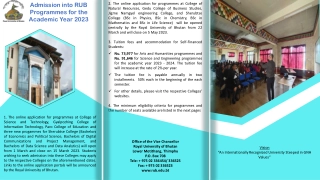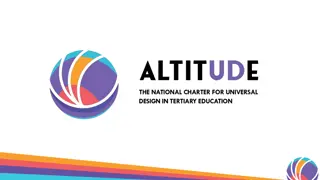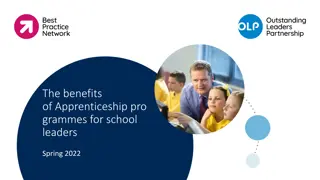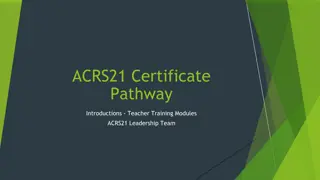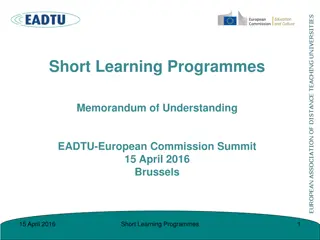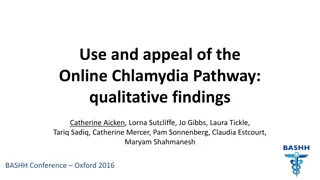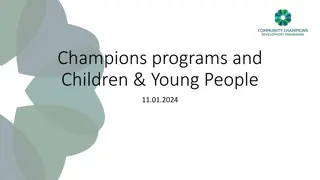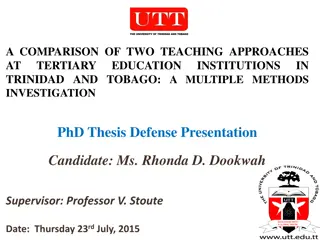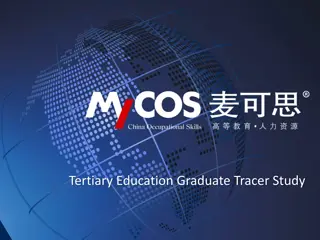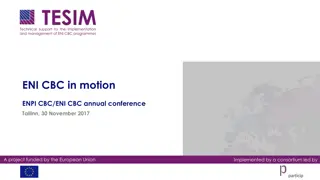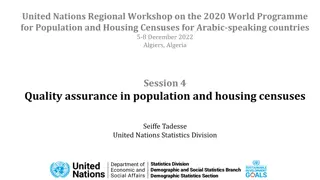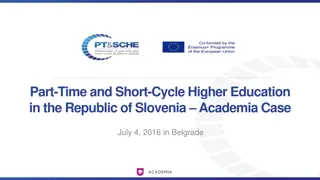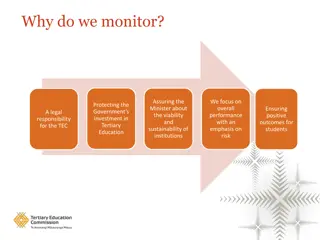Short Learning Programmes: A Flexible Pathway to Tertiary Education
Short learning programmes offer a flexible pathway to tertiary education by providing micro-credentials that respond to labor market needs, focusing on ICT, renewables energies, automotive, and sustainable mobility. These programmes are designed to enhance skills, improve workforce readiness, and bridge the gap between higher education and professional systems. Quality assurance measures ensure the applicability and recognition of these programmes in official degrees, catering to non-traditional students for upskilling and re-skilling opportunities.
Download Presentation

Please find below an Image/Link to download the presentation.
The content on the website is provided AS IS for your information and personal use only. It may not be sold, licensed, or shared on other websites without obtaining consent from the author. Download presentation by click this link. If you encounter any issues during the download, it is possible that the publisher has removed the file from their server.
E N D
Presentation Transcript
SHORT LEARNING PROGRAMMES. A FLEXIBLE PATHWAY TO ACCESS TERTIARY EDUCATION Esther Huertas*, Carme Edo, Teresa Pitarch (ehuertashidalgo@aqu.cat)
Introduction Labour market needs Catalan Catalan Public Employment Service Catalan Continuous Training Consortium Secretariat for Universities and Research University Quality Assurance Agency Higher education system 3
Main characteristics Focus Lever for change Principles Professional qualifications in the occupation. Response to labour market needs. (Transition towards digitalization and green economy) Improvement of skills (workforce). Micro-credentials. EHEA principles. Quality and transparency (ESG). Gateway between HE and professional system. LLL. Government s willingness. HEI collaboration. Flexibility. 4
Short learning programmes ICT Renewables energies Automotive and sustainable mobility 7 SLP 33 SLP x 9 HEI. 8 15 ECTS Level 6 EQF, except: Data scientist (level 7 EQF) 8 SLP 6 SLP x 1 HEI. 6 13 ECTS Level 6 EQF, except: Storage technologies + Businness plannin in energy transition (level 7 EQF) 8 SLP 0 SLP x HEI. 7 9 ECTS Level 6 EQF, except: Advanced driver assistance systems (ADAS) (level 7 EQF) 5
Short learning programmes Strong applicability (occupational character). Level 6 and 7 of EQF / level 4 and 5 of CNCP. 4 30 ECTS. ECTS recognition in official degrees. Provider: HEI. Target audience: non-traditional students (re-skilling / upskilling; employed / unemployed). Quality assurance: ex-ante evaluation. 6
Quality and transparency Qualification frameworks ESG [ ] provide guidance, covering the areas which are vital for successful quality provision and learning environments in higher education . Students interests protection Quality assurance ECTS [ ] The term programme in these standards refers to higher education provision in its broadest sense, including provision that is not part of a programme leading to a formal degree. Recognition 7
Quality assurance - SLP SLP Programme evaluation. Ex-ante evaluation. ESG ESG 1.2 design & approval of programmes ESG 1.3 SCL, teaching & assessment ESG 1.5 Teaching staff 8
Assessment dimensions - Pilot 1. Description of SLP: university, name of SLP, EQF level, relationship with the professional family, ECTS, mode of delivery, offer Rationale: relevance of the program to labour market, and potential of the institution to deliver the programme Aims and learning outcomes Student access, admission & student support Planning of SLP: structure of the curriculum, modules, LO. Teaching and support staff Material resources and services IQAS 2. 3. 4. 5. 6. 7. 8. https://www.aqu.cat/es/doc/Universitats/Metodologia/Guia-acreditacion-ex-ante-de- programas-de-corta-duracion-PCD
Implementation High complexity in the management of requests (duplication of information; high bureaucracy). Lack of attention to the uniqueness of universities Problems in recruiting and completing students. Special attention to guarantee the EQF level. Workload associated to external review and the short period of time life of SLP, another strategy more focused on the IQAS. 10
Conclusions High commitment from universities. Gateway between HE and professional system. Be part of the vocational training programs subsidized by the public employment service. Adjust and align the way of working between universities and employment services, making processes more flexible and recognizing the way of working of universities. Establish a common language. Simplify external review procedures. 11
The future.... The Universities of the future will be more open, transparent and flexible institutions. They will be better adapted to a constantly changing landscape. + http://www.e-architect.co.uk/images/jpgs/switzerland/rolex_learning_center_b170210_hs2.jpg EPFL Rolex Learning Centre (A. Teixeira, Barcelona 2018) 12
Thank you! Esther Huertas (ehuertashidalgo@aqu.cat)


